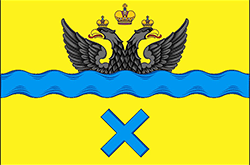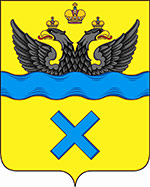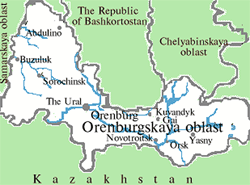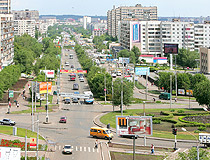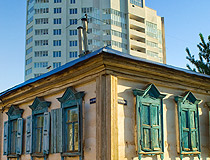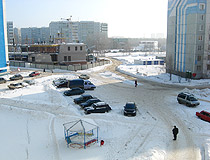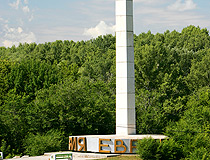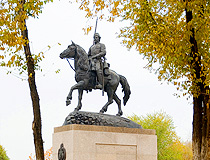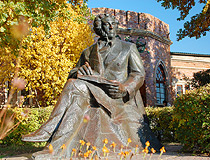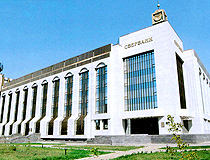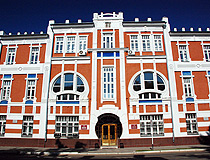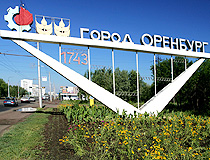History of Orenburg
Foundation of Orenburg
In October 1715, a significant part of the meeting of Kazakh elders headed by Abulkhair Khan spoke out in favor of adopting an act on the voluntary annexation of the Younger Zhuz of Kazakhs (a significant part of today’s western Kazakhstan) to the Russian Empire. In 1734, Abulkhair Khan pledged to protect the security of the Russian borders and merchant caravans passing through the Kazakh steppes.
As a reward for this, he asked to approve the khan’s succession to the throne for his family and build a town with a fortress on the Or River, where he could find refuge in case of danger. In 1735, the Orenburg fortress was laid at the confluence of the Or and Yaik (Ural) rivers.
In 1739, river floods in this place forced preparations for the construction of a new town with the same name downstream of the Yaik River, on Krasnaya (Red) Mountain. In 1741, it was founded. The old town was named the Orsk fortress (the present city of Orsk), but the construction of the new town did not begin as the chosen place was treeless, rocky and remote from the river - unsuitable for town construction.
In 1743, Orenburg was founded for the third time, on the site of the former Berd fortress, at the confluence of the Sakmara River with the Yaik. Today, it is the historic center of the city. Since Orenburg was originally founded on the Or River, it was named Orenburg - a town on the Or. In connection with such a confusing history of founding, Orenburg is called three times conceived and once born.
In 1744, it became the center of the Orenburg Governorate stretching from the Volga River to Siberia, from the Kama River to the Caspian Sea. Orenburg was built as a fortress town guarding the southeastern border of the Russian Empire. At the same time, it was supposed to serve as a center of trade with the peoples of the East. Therefore Orenburg had both military and commercial significance.
More Historical Facts…
Orenburg in the late 18th - 19th centuries
During the peasant war of 1773-1775, Orenburg underwent a long siege under the leadership of Yemelyan Pugachev. At that time, it was the main fortress in the south-east of the country. Powerful fortifications allowed Orenburg to withstand a six-month siege. After the suppression of the uprising, as punishment, Empress Catherine II renamed the Yaitsk Cossacks into the Ural Cossacks, the Yaitsk town - into Uralsk, the Yaik River - into the Ural River.
For the successful defense of the fortress, the townspeople of Orenburg were presented with the cross of St. Andrew the First-Called (X). Today, this cross is depicted on the flag and coat of arms of Orenburg.
In 1811, the population of Orenburg was about 5,400 people. At the end of the 18th - beginning of the 19th centuries, the first Catholics appeared in Orenburg, since after the divisions of the Polish-Lithuanian Commonwealth a large number of Poles were exiled here. In the 19th century, the Polish diaspora in Orenburg increased because of the exiled participants of the Polish uprisings. In 1847, a Catholic church was built and consecrated in Orenburg (this building has been preserved and can be found at 8th Marta Street, 24).
In 1862, the Orenburg fortress was officially abolished due to the loss of its strategic importance. The functions of a border outpost on the southern borders of the Russian Empire were transferred to Tashkent. The liquidation of the fortress coincided with the abolition of serfdom and the development of capitalism in the country, which gave a powerful impetus to the development of Orenburg. In 1863, its population was about 27,600 people.
The town was a major center of trade between the Russian Empire and Central Asia. The local industry (production of flour, oil, leather) began to develop rapidly with the construction of the Samara - Orenburg railway in 1877. The Orenburg region also became famous for its downy shawls knitted from the down of specially bred Orenburg goats.
Orenburg also became a major trade and distribution center for livestock and meat coming from the Kazakh steppes. In 1881, the first in the Russian Empire plant for the production of condensed milk was opened in Orenburg. In 1894, the construction of the Kazan Cathedral was completed - one of the main symbols of the city (destroyed in the 1930s).
Orenburg in the first half of the 20th century
At the beginning of the 20th century, Orenburg was a major trade and economic center. In 1905, the construction of the Tashkent railway was completed, which opened the way to Central Asia and made the city an important transport hub.
In 1914, the population of Orenburg, the largest city in the Urals, was about 100 thousand people. During the anti-German campaign in connection with the outbreak of the First World War, the Orenburg City Duma considered the issue of renaming the city (at the same time Saint Petersburg was renamed Petrograd). Here are some of the proposed new names: Oriengrad, Oriendar, Yaitsk, Priuralsk, Neplyuevsk, Sakmaro-Uralsk. However, the renaming did not take place at that time.
Interesting fact. Orenburg was the first capital of Soviet Kazakhstan. In 1920, this city became the administrative center of the created Kyrgyz Autonomous Socialist Soviet Republic (the Kazakhs were officially called the Kyrgyz at that time). In April 1925, the Kyrgyz ASSR was renamed the Kazakh ASSR, and its capital was moved from Orenburg to Ak-Mechet, renamed Kzyl-Orda.
Orenburg became part of the Russian Soviet Federative Socialist Republic. In December 1934, it became the capital of Orenburg Oblast. In the 1930s, almost all of its more than 40 Orthodox religious buildings were demolished. Without these architectural dominants, Orenburg largely lost its unique and attractive historical appearance.
On December 26, 1938, Orenburg was renamed Chkalov in honor of the deceased test pilot V.P. Chkalov, despite the fact that Chkalov had never visited this city. The renaming was also explained by the fact that there were plans to make Orenburg “the aviation capital of the USSR”. In 1939, a downy shawl factory was opened. The population of Orenburg was about 172 thousand people.
During the Second World War, about 40 factories were evacuated to Orenburg and it became an industrial center. By May 1942, the number of people evacuated here reached 75 thousand. By 1943, the gross industrial output of the Orenburg region increased more than 4 times since the beginning of the war.
Orenburg in the second half of the 20th century and beyond
On November 7, 1953, a monument to Valery Chkalov was unveiled. On December 4, 1957, the original name was returned to the city - Orenburg. In 1959, its population was 267 thousand people.
Yuri Gagarin, the first human to journey into outer space, trained as a pilot at the Orenburg Military Aviation Flight School. Gagarin is an honorary citizen of Orenburg. In 1961, the MiG-15 - a fighter jet that cadet Gagarin flew on - was installed on a pedestal near the aviation school. The House-Museum of Cosmonautics was also opened there with some of Gagarin’s personal belongings.
In November 1966, on the left bank of the Ural River, not far from the city, a large Orenburg oil and gas condensate field was discovered. A new Orenburg territorial-industrial complex of all-Union significance began to form. It was based on gas production, processing and transportation enterprises. This event can be called the second birth of Orenburg. In less than 10 years, it became one of the largest natural gas suppliers in Russia.
In 1979, according to the All-Union census, the population of Orenburg was 458 thousand people. In connection with the development of the Orenburg gas condensate field, urban planning activities received a powerful impetus for rapid development. About 30 kilometers from Orenburg, a unique gas processing plant, the largest in Europe, was built according to the project of French specialists.
In 1989, the population of Orenburg was about 546 thousand people. After the collapse of the USSR, Orenburg experienced some depopulation in the 1990s. In the late 1990s, the gas field began to run out.
At the beginning of the 21st century, the development of the city began again, associated primarily with the activities of the enterprise “Gazprom dobycha Orenburg”.
Orenburg views
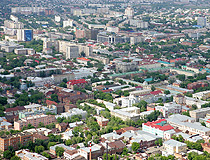
General view of Orenburg
Author: Boris Yartsev
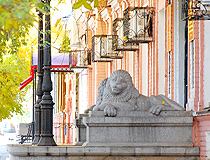
On the street in Orenburg
Author: Kiyanovsky Dmitry
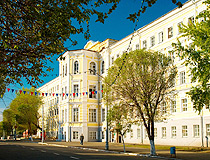
Orenburg architecture
Author: Boris Yartsev
Orenburg - Features
According to popular belief, Orenburg is located both in Europe and Asia. On the pedestrian bridge across the Ural River you can see a symbolic sign of the border between Europe and Asia. However, this border was not officially recognized by the International Geographical Union in 1959, when the opinion of Soviet scientists was accepted about the border between Europe and Asia.
By their definition, the Ural River is a natural water border between Asia and Europe only in its upper reaches on the territory of Russia. In the place where Orenburg is located, it is a completely European river and from a geographical point of view Orenburg can be considered a European city.
The climate of Orenburg is moderately continental transitional to sharply continental. Summers are hot and dry, winters are moderately cold. Temperatures fluctuate greatly depending on the time of day and wind direction. In summer, the temperature can rise to plus 40 degrees Celsius or drop to plus 5 degrees Celsius.
In winter, the weather ranges from mild frosts to severe cold weather, sometimes mild thaws or severe colds down to minus 40 degrees Celsius. The average temperature in January is minus 11.8 degrees Celsius, in July - plus 22.3 degrees Celsius.
On the coat of arms of Orenburg repeating the historical coat of arms adopted at the end of the 18th century, you can see a schematic representation of the Ural River. The Azure Cross of St. Andrew (X) is an award given to the garrison of Orenburg for its successful defense during the siege by the troops of Yemelyan Pugachev (the peasant war of 1773-1775).
In the industry of Orenburg, the leading places belong to the gas production and gas processing industries, mechanical engineering and metalworking. The enterprises of the chemical industry, food and light industries are also developed.
Orenburg is a large railway junction where the railway lines to Samara, Orsk, Ufa, Uralsk (Kazakhstan), Aktobe (Kazakhstan) intersect. The federal highway R239 Kazan - Orenburg - Akbulak - the border with the Republic of Kazakhstan passes through the city. Orenburg Central International Airport named after Yuri Gagarin offers regular flights to Moscow, St. Petersburg, Sochi, Novosibirsk, Yekaterinburg, Kazan, Ufa, Novy Urengoy.
One of the symbols of this city are unique Orenburg shawls made of goat down, which are distinguished by fine workmanship, original pattern, beauty of decoration, durability, and ability to keep warm.
Remarkable architectural monuments that have survived since the founding of the city, monumental art, local traditions create a special unique atmosphere of the city and rightfully allow Orenburg to be considered a unique city with a rich culture and history.
Main Attractions of Orenburg
Sovetskaya Street - the main tourist alley of Orenburg, about 3 km long; part of it is completely pedestrian. An interesting story can be told about almost every building located on this street: the house #1 is the aviation school, which Yuri Gagarin graduated from; the house #2 - the former residence of the military governors of Orenburg; in the house #3, the Decembrists lived in the 1820s; the house #4 - one of the oldest buildings in Orenburg, constructed in the middle of the 18th century; the house #23 - Orenburg Gostiny Dvor; the house #26 - the drama theater named after Maxim Gorky (one of the oldest theaters in the Urals); the house #27 - a picturesque clock tower; the house #28 - Orenburg Museum of History and Local Lore.
Pedestrian “White Bridge” from Europe to Asia. The first wooden bridge across the Ural River was built in 1835. Every year, after the spring flood, it had to be repaired. The modern metal structure was built only in 1982. The bridge has a certain symbolic meaning, as it allows pedestrians to travel from Europe to Asia and back. The bridge leads from the historic center of Orenburg to the park “Zauralnaya Roscha”.
Aerial Lift “Europe-Asia”. In 2006, parallel to “White Bridge”, a 233-meter aerial lift (cable car) was opened, along which you can get from Europe to Asia by air in cozy translucent cabins. During the trip, which takes about 5 minutes, you can take pictures of the Ural River, the bridge and the Orenburg embankment from a height of 70 meters. It can be found opposite the house #16 on Naberezhnaya Street.
Museum of the History of Orenburg - a local history museum located next to the aerial lift “Europe-Asia” in a picturesque red brick building constructed in the middle of the 19th century, an interesting architectural monument resembling a medieval castle. Its clock tower looks especially impressive. Initially, this building housed the city treasury and archive. The diverse exposition of the museum covers all periods of the history of Orenburg. One of the halls is devoted to the life of A.S. Pushkin in Orenburg. Naberezhnaya Street, 29.
Orenburg Museum of History and Local Lore. The main expositions of this museum are located in a luxurious merchant mansion in the city center, an architectural monument of the 19th century. Its archaeological collection of great interest, the pearl of which is the “Sarmatian gold” - a collection of objects found in the process of researching burial mounds and burial grounds in the Orenburg region, dating back to the 4th century BC.
In addition to archaeological monuments, the museum has interesting ethnographic exhibits, art metal products, a numismatic collection, a collection of textiles and embroidery. The expositions of the museum also tell about the nature and history of the Orenburg region. Sovetskaya Street, 28.
Orenburg Regional Museum of Fine Arts. The collection of this museum, located in a mansion of the early 19th century, includes works of Old Russian, Russian, Bashkir, Soviet, and Western European art created from the end of the 16th century: graphics, paintings, sculptures, icons, decorative and applied art, etc. Kashirina Lane, 29. The gallery “Orenburg downy shawl”, a branch of this museum, is located at Volodarskogo Street, 13.
Cultural Complex “National Village” - a museum and ethnographic complex built near Yuri Gagarin public garden in the 2000s. It represents the national farmsteads of the peoples living in the Orenburg region: Russians, Tatars, Kazakhs, Ukrainians, Bashkirs, Mordvinians, Belarusians, Armenians, Germans, Chuvash. On the territory of the complex there are museums of everyday life and culture, restaurants of national cuisine, libraries with literature in different languages, and souvenir shops.
Various events are often held here, including performances by folklore ensembles, traditional festivities. This is a great place to see a variety of architectural styles, get to know the traditions and cultures of different nations. Altayskaya Street, 5.
Cathedral of St. Nicholas the Wonderworker (1883-1886) - the only church in Orenburg not demolished in the 1930s. Divine services in the church began to be held again in 1944. In the 1980s-1990s, the building was restored and expanded. Today, it is one of the most visited churches in Orenburg. Chkalova Street, 8.
Historical and Architectural Complex “Caravanserai” (1837-1846) - one of the most important sights of the southern Urals embodying the most striking national and stylistic features of the architecture of the Orenburg region of the 19th century, an architectural monument consisting of the main building, a mosque, and a minaret. It was used as the administrative building of the Bashkir Cossack army and the governor of the region. Parkovyy Avenue, 6.
Frunze Garden. In 2005, a memorial complex and an open-air museum “Salute, Victory!” was opened here. It consists of expositions of military equipment, weapons and thematic sculptural compositions. One of the most interesting exhibits is the huge Voevoda (SS-18) intercontinental ballistic missile. Kirova Street, 1.
Orenburg Water Tower (1927-1929) - a picturesque 28 meters high monument of urban planning and architecture of regional significance built in the style of classicism. Later, some elements in the constructivist style were added. Pobedy Avenue, 14/1.
Orenburg Children’s Railway (1953) - one of the longest railways for children in Russia (about 6 km). The train stops at three stations - Komsomolskaya, Kirovskaya, Dubki. If you get off at Komsomolskaya station, you will get to the Orenburg city center near the pedestrian bridge across the Ural River. Kirovskaya and Dubki stations lead to children’s health camps. Throughout the entire route, the railway runs in the floodplain of the Ural River. Kirova Street, 37. You can ride the train only in summer, on Wednesday, Thursday, Saturday, and Sunday.
Private Museum-Shop of the Orenburg Downy Shawl. The museum displays historical exhibits that tell about the emergence and development of this unique craft. Znamenskiy Proyezd, 1/1.


